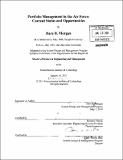Portfolio management in the Air Force : current status and opportunities
Author(s)
Morgan, Dave B
DownloadFull printable version (7.798Mb)
Other Contributors
System Design and Management Program.
Advisor
Ricardo Valerdi.
Terms of use
Metadata
Show full item recordAbstract
There are hundreds of weapons programs, under the management of the United States Air Force worth billions of dollars. These programs are being developed to fulfill a need in the U.S. defense strategy. Bringing these weapon systems to operational status is not an easy process. It takes communication and coordination of many stakeholders and development of state-of the-art technology. More often than not, weapons programs are developed with the final cost and schedule being much higher that forecasted. Inherently weapons systems are expensive, however the costs of these systems continue to rise with no apparent end in sight. The Government Accountability Office, RAND, Congressional studies and the Defense Acquisition Performance Assessment have has criticized the Department of Defense for escalating costs. These studies point to poor requirement definition, errors in cost and scheduling forecasts, poor oversight, bad decisions by the government, and failure to adopt recommendations from reform policies as the main causes. One way ameliorate cost escalation is to employ portfolio management technique. The Air Force groups their weapon systems into 20 portfolios. Some form of portfolio management has been employed for the last decade. Portfolio management cannot solve the issues above but it can offer a solution that can potentially save millions and perhaps billions of dollars This thesis examines the Air Force's current use of Portfolio Management theory and what opportunities we can do to improve it in the acquisition community. The thesis poses three research questions: 1) How can the Air Force better employ portfolio management to curb cost overruns and schedule delays in their weapon acquisition programs? 2) What can the Air Force do to empower portfolio managers for success? 3) What barriers can the Air Force eliminate or streamline to help portfolio managers execute their portfolios more effectively and efficiently. Acquisition professionals were interviewed to glean their perspectives and opinions. More specifically acquisition personnel were asked how portfolio management was being executed and how can the Air Force improve this technique to better execute weapon systems programs. From these interviews and the research conducted, the following recommendations were made: 1) Program Executive Officers should be given more authority with respect to utilizing funds and hiring of specialized personnel 2) The Air Force needs to streamline the process for reallocating funds and, 3) The Air Force needs to modify number of reporting requirements and policy changes to make the process more efficient and effective.
Description
Thesis (S.M. in Engineering and Management)--Massachusetts Institute of Technology, Engineering Systems Division, System Design and Management Program, 2011. Cataloged from PDF version of thesis. Includes bibliographical references (p. 65-68).
Date issued
2011Department
System Design and Management Program.; Massachusetts Institute of Technology. Engineering Systems DivisionPublisher
Massachusetts Institute of Technology
Keywords
Engineering Systems Division., System Design and Management Program.